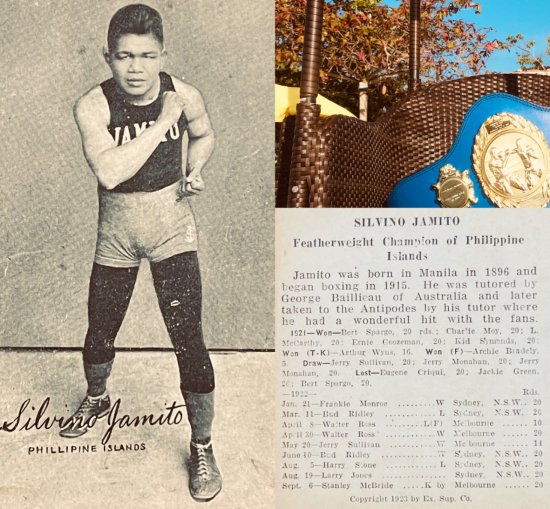
|
Philippines, 28 Dec 2025 |
Home >> News |
 |
||||
|
|
|
|
Silvino Jamito: The First Filipino International Boxing Star By Emmanuel Rivera, RRT PhilBoxing.com Thu, 22 Feb 2024  Silvino Jamito, the first Filipino boxer to journey to Australia, lived his mantra to the fullest: "Have gloves, can fight, will travel." Born on February 2, 1894, in Talisay, Camarines Norte, he possessed moxie and delivered more punches than he received— a quality highly appreciated by aficionados of the fight game. Throughout his illustrious career, which comprised an astounding 188 fights, Jamito boasted an official yet somewhat misleading record of 77 wins (12 by KO), 71 losses (8 by KO), and 39 draws, per BoxRec.com and BoxerList.com. Like many Filipino youths during the Philippine-American War and occupation around 1912, Jamito served as a factotum and all-around helper. Initially employed by a wealthy Spanish family, he later assisted American Edward Gallaher, a US Marine and entrepreneur who organized boxing events in Subic Bay, Olongapo. Amidst the turmoil of World War I and the Philippine-American conflict, Jamito enlisted in the Philippine Army. It was under the guidance of US Marine Edward Gallaher, who promoted military boxing matches in Olongapo, that Jamito discovered his knack for boxing. Observing soldiers and sailors train, spar, and fight, Jamito received formal training from Stewart Tait before engaging in his first fight. Jamito's debut victory came on December 13, 1913, with a KO3 win against David Paulino. The following year, he commenced with a draw (4/4) against Francisco Gamboa on February 28, 1914, followed by eight victories. However, his winning streak was stopped by a points loss to Paul Gyn (8/8) on July 18, 1914. Despite his earlier successes, Jamito's career began to decline in the Philippines. However, fate intervened when he crossed paths with George Bailleau, an Australian writer, promoter, and ad man who recognized Jamito's potential. Bailleau believed that with sufficient resources and training, Jamito could compete with the best. Together with Maximiano (Macario) Villon and Francisco Reyes, Jamito embarked on a journey to Australia, setting sail on the NYK steamship Nikko Maru in August 1919.  Jamito's arrival in Australia sparked a wave of interest in Filipino boxing, prompting a succession of Filipino boxers to seek fame and fortune. Despite facing overt racism, Jamito captivated audiences with his aggressive tactics and remarkable skill. Boxing writer and editor of The Referee, W.F. Corbett, lauded Jamito's prowess, attributing his success to his natural abilities more than hard work and ingenuity, unfairly depicting Filipinos as savages. Despite facing formidable opponents, Jamito's matches in sold-out arenas were thrilling displays of his talent and determination. However, despite his remarkable performances, Jamito faced setbacks in The Land Down Under, including spirited losses to two of his late friend and pupil Dencio Cabanela's opponents, Eugene Criqui (L 20 rd) on February 19, 1921, and Bert McCarthy (L20 rd) on September 20, 1921. After his time in Australia, Jamito migrated to the United States, where he continued to fight despite declining skills. His final bout ended in defeat, a swift TKO 2/12 at Queensboro Stadium in Long Island, New York, on July 24, 1928. Following his retirement from boxing, Jamito tried driving public transportation in the East Coast before eventually settling in Salinas, John Steinbeck’s neck of the woods, where he worked in agriculture. He left behind a comfortable inheritance for his Australian wife and their child, Sydney. Jamito passed away at the age of 56 on February 16, 1950 in Monterey, California, leaving behind a legacy of resilience, determination, and unmatched skill in the boxing world. Anne R. Tapp’s research paper entitled "Slam Jam" The Australian "Oriental Fancy" Silvino Jamito”, encapsulated the life and times of the first Filipino international boxing star and his challenges in the Antipodes. “Jamito's popularity defied many precepts that indicate sports idols reflect or embody national characteristics. For a Filipino boxer to become, if not an idol, then a very popular Australian sporting figure in a country that supported a White Australia policy was incongruent with mainstream racial rhetoric. However, values with which most Australians could identify were attributed to Jamito: he was a Christian, a hard worker in the mold of the "Aussie battler", a family man, a decent fighter who abided the rules of sport, open and honest in his actions-always training in public view, uncomplaining, accepting of the Australian way of life, and a "bit of a larrikin" in the ring.”  The Philippine Boxing Historical Society and Hall of Fame proudly commemorate Mr. Silvino Jamito for his tremendous contributions to Philippine boxing history. Notes: • Photos of Silvino Jamito are part of the collection of the Philippine Boxing Hall of Fame (Public Domain) and are reprinted for non-commercial use in compliance with the United States Fair Use Doctrine. • It with respect and gratitude that we mention Anne R. Tapp and her historical documentary "Slam Jam" The Australian "Oriental Fancy" Silvino Jamito”, Asian Studies Review, April 1994, page 143 http://dx.doi.org/10.1080/03147539408712959. Reprinting rights obtained from http://www.tandfonline.com/loi/casr20 by Philippine Boxing Historical Society) Click here to view a list of other articles written by Emmanuel Rivera, RRT. |
|
|
PhilBoxing.com has been created to support every aspiring Filipino boxer and the Philippine boxing scene in general. Please send comments to feedback@philboxing.com |
PRIVATE POLICY | LEGAL DISCLAIMER
developed and maintained by dong secuya © 2025 philboxing.com. |